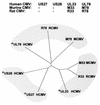Murine cytomegalovirus (CMV) M33 and human CMV US28 receptors exhibit similar constitutive signaling activities
- PMID: 12134021
- PMCID: PMC155159
- DOI: 10.1128/jvi.76.16.8161-8168.2002
Murine cytomegalovirus (CMV) M33 and human CMV US28 receptors exhibit similar constitutive signaling activities
Abstract
Cellular infection by cytomegalovirus (CMV) is associated with very early G-protein-mediated signal transduction and reprogramming of gene expression. Here we investigated the involvement of human CMV (HCMV)-encoded US27, US28, and UL33 receptors as well as murine CMV-encoded M33 transmembrane (7TM) receptors in host cell signaling mechanisms. HCMV-encoded US27 did not show any constitutive activity in any of the studied signaling pathways; in contrast, US28 and M33 displayed ligand-independent, constitutive signaling through the G protein q (Gq)/phospholipase C pathway. In addition, M33 and US28 also activated the transcription factor NF-kappaB as well as the cyclic AMP response element binding protein (CREB) in a ligand-independent, constitutive manner. The use of specific inhibitors indicated that the p38 mitogen-activated protein (MAP) kinase but not the extracellular signal-regulated kinase 1/2-MAP kinase pathway is involved in M33- and US28-mediated CREB activation but not NF-kappaB activation. Interestingly, UL33-the HCMV-encoded structural homologue of M33-was only marginally constitutively active in the Gq/phospholipase C turnover and CREB activation assays and did not show any constitutive activity in the NF-kappaB pathway, where M33 and US28 were highly active. Hence, CMVs appear to have conserved mechanisms for regulating host gene transcription, i.e., constitutive activation of certain kinases and transcription factors through the constitutive activities of 7TM proteins. These data, together with the previous identification of the incorporation of such proteins in the viral envelope, suggest that these proteins could be involved in the very early reprogramming of the host cell during viral infection.
Figures







References
-
- Abubakar, S., I. Boldogh, and T. Albrecht. 1990. Human cytomegalovirus stimulates arachidonic acid metabolism through pathways that are affected by inhibitors of phospholiphase A2 and protein kinase C. Biochem. Biophys. Res. Commun. 166:953-959. - PubMed
-
- Alford, C. A., and W. J. Britt. 1995. Cytomegaloviruses, p. 2493-2534. In B. N. Fields, D. M. Knipe, and P. M. Howley (ed.), Fields virology. Lippincott-Raven Publishers, New York, N.Y.
-
- Ambinder, R. F., K. D. Robertson, and Q. Tao. 1999. DNA methylation and the Epstein-Barr virus. Semin. Cancer Biol. 9:369-375. - PubMed
Publication types
MeSH terms
Substances
LinkOut - more resources
Full Text Sources
Other Literature Sources

